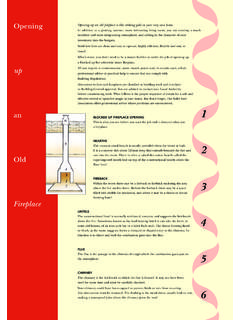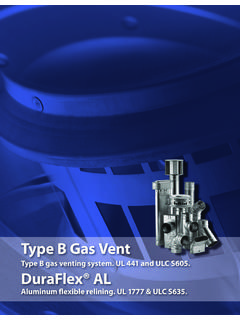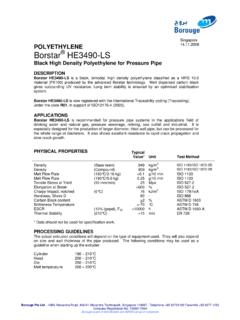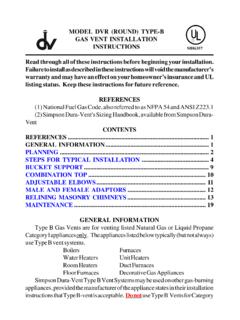Transcription of LINING OLD CHIMNEYS - Solid Fuel Association
1 LINING OLD most appealing focal point in any room must be the fireplace. Be it an open fire, closed stove or roomheater, the leaping flames and glowing coals are the real heart of the , for any fire to work successfully, it must be connected to a sound chimney and correctly sized flue. The functions of a chimney are to safely remove the products of combustion from the fireplace or appliance to outside without causing danger to the occupants of the house or setting the house itself on fire. A chimney works because hot air rises and always moves from high to low pressure.
2 Factors such as running the appliance at a very slow rate or cold air leaking into the flue, will cool the gasses and affect the performance of the chimney. To keep the flue gasses warm, consideration must be given to the insulation value of the LINING system houses built since the introduction of the 1965 Building Regulations, all flues must be built with liners during their construction. This is usually done with clay liners, which should last the life of the building. However, in houses built prior to 1965, LINING was less common.
3 Flues were usually parged (rendered) on the inside with lime mortar. This parging suffers attack from acids and tars produced during combustion, and gradually deteriorates. The flue is then in poor condition, often leaking fumes or tars into the walls or other parts of the building. Sadly, many houses built since 1965 suffer similar problems due to badly installed flue liners and need further proceeding further it is important to understand the terms used when talking about CHIMNEYS .
4 These are briefly as follows:FLUE The flue is the void or passageway through which the products of combustion are removed from the fire to the A chimney is the structure surrounding one or more flues. FLUE LINER The flue lineris the material used to form the flue or flues within a TERMINAL This is the pot, cowl or other method of finishing the top of the PIPE is a metal pipe used to connect an appliance to the flue in a FOR LININGT here are a number of reasons why an old chimney may need flue is leaking smoke and fumes into other rooms or parts of the building.
5 2. Condensates or tar are seeping through the chimney walls causing staining, either inside or outside the building (a common problem with wood burning stoves)3. The flue is much too large for the type of fire or appliance being The flue is too cold, particularly if on an outside wall, and is not drawing If the chimney was built since 1965, but with the liners fitted the wrong way up, tar and condensate leakage may The old flue surface is eroded and rough, causing frictional resistance to the flow of the gasses resulting in poor METHODS OF LININGS everal methods are available for inserting a LINING into an existing flue.
6 A brief list of these is as follows:1. Rigid sections of clay or refractory liner installed by cutting into the flue wall or by lowering down from the top of the concrete pumped inaround an inflatable former by a specialist Flexible metal liner in a continuous length lowered down the on coating by specialist Ceramic coating by specialist of these methods have some advantages and some drawbacks. Their suitability will depend on individual circumstances. Good professional advice on the most appropriate system is any new LINING is installed it is essential to have the chimney thoroughly swept to remove all soot and tar deposits.
7 This means with stiff polypropylene or steel scraper brushes. Preferably use a member of the National Association of Chimney Sweeps, who work to a Code of Practice and provide a certificate on completion. It is possible in some situations to ream out the old flue to take a larger liner than would otherwise fit. This work is done by a specialist contractor, who may also offer a video camera inspection of the all cases it is advisable to use a system that has a recognised test approval and if a guarantee is offered it should be underwritten by following sections will look at each of the above in more detail:E.
8 RIGID REFRACTORY LINERSThis is the most traditional method of LINING using refractory concrete, clay or ceramic liners of the same type commonly used in new build. There are also some pumice liners designed specifically for relining. The chimney has to be opened at frequent intervals to insert the liners, essential if there are bends in the flue. The resulting dust, mess and subsequent redecorating are not popular with the the old flue is large enough and straight it is often possible to lower liners down from the top without opening the flue inside the house.
9 Several specialist companies offer this system. The liners must either have rebated and socketed joints or steel locking bands. (NB rebated and socketed joints must be fitted the correct way up. Rebates are there to prevent any condensates running down the flue from leaking out, therefore the socket end must be uppermost and the spigot end fitting down inside the lower pipe). A possible drawback with this method is the wall thickness of the liner, usually 20-25 mm. Twice this dimension plus a clearance needs to be deducted from the size of the original flue, resulting in a much reduced flue cross section.
10 For a nominal 225x225mm flue this probably means only a 150mm or 175mm flue can be achieved. This reduced size will be too small for an open fire so a closed appliance may have to be fitted. Clay liners used in this method must comply with BS EN 1457 : 1999. Refractory concrete liners with a much higher insulation value and ability to withstand thermal shocks such as in a chimney fire are to be recommended, particularly for wood burning stoves. Liners made with pumice and high alumina cement are best and comply with Building the product should have a British Board of Agr ment Certificate.







